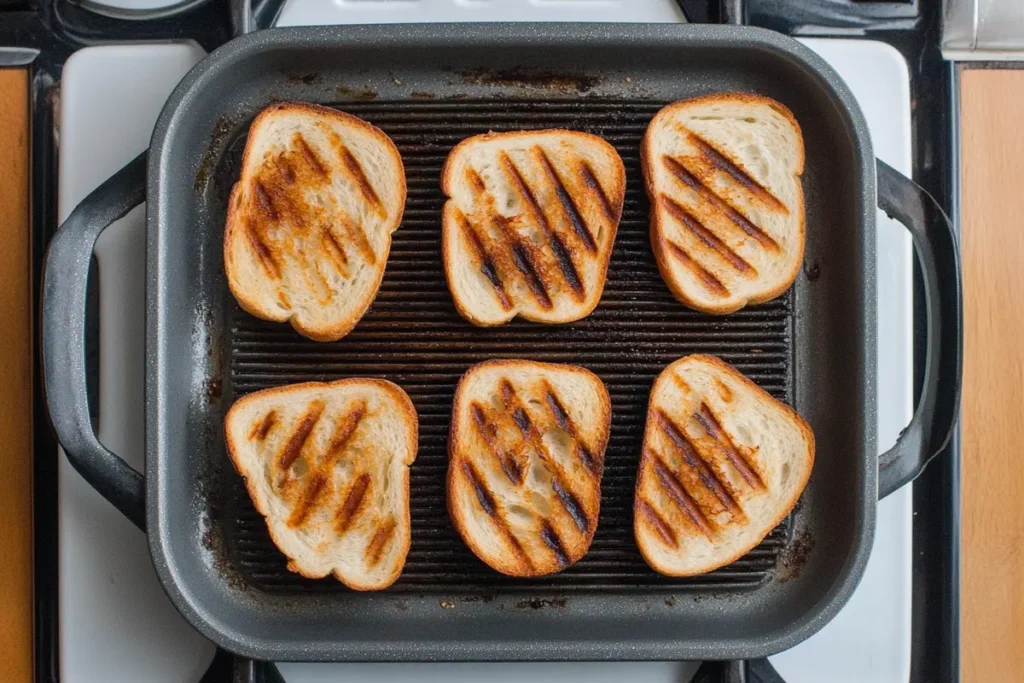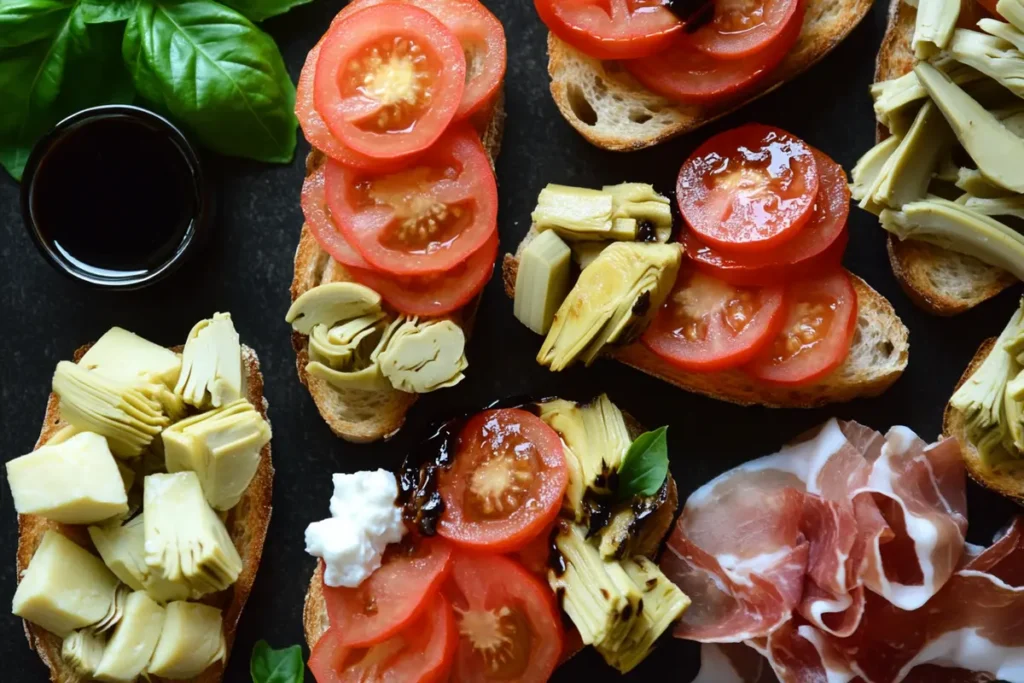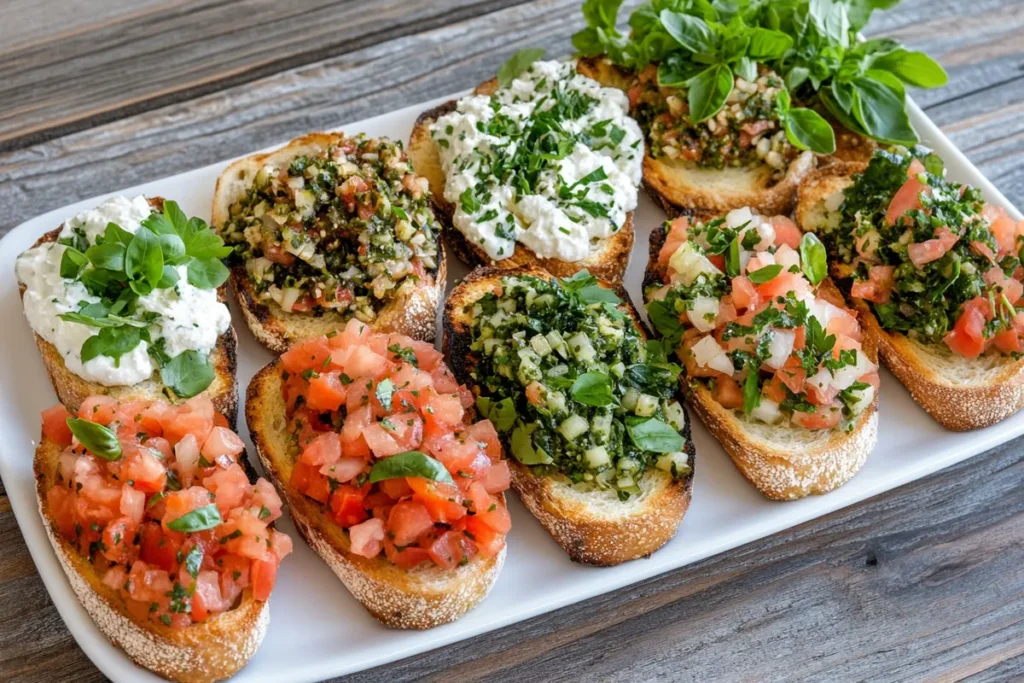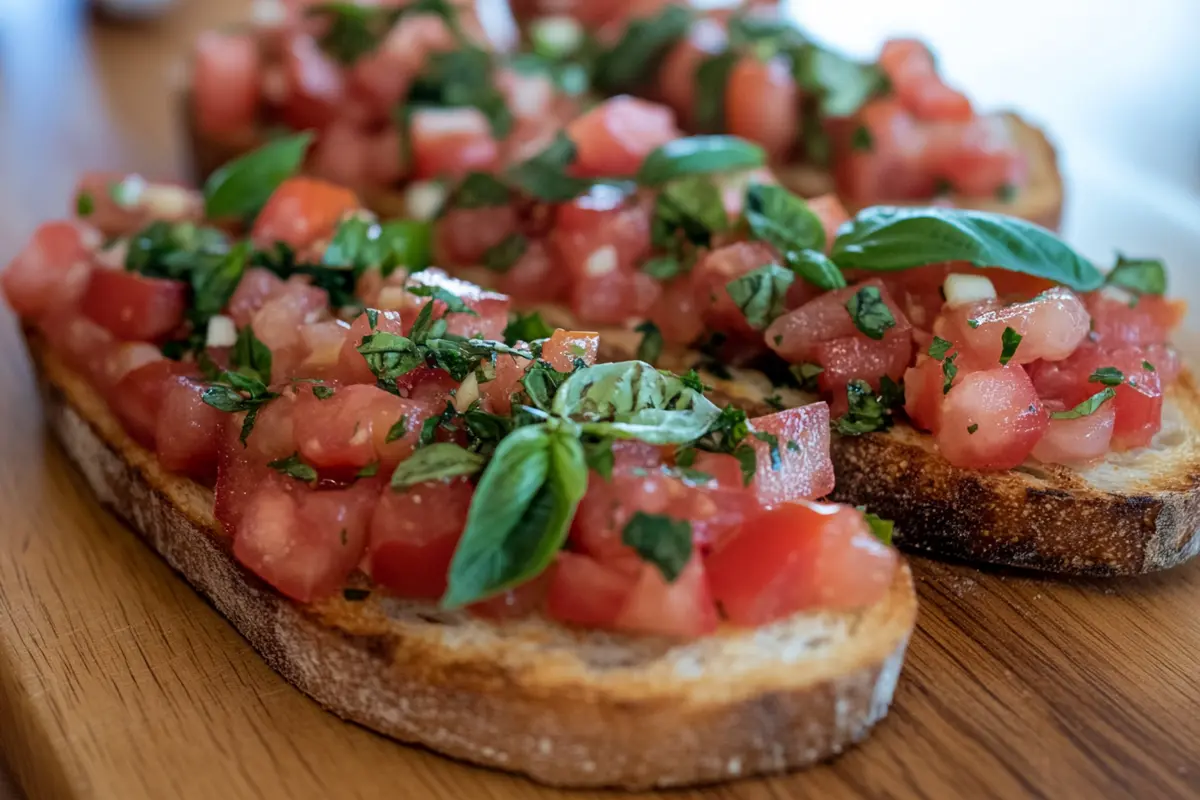Bruschetta is a popular dish often enjoyed as an appetizer. It is also used as a base for many meals. However, what is the meaning of bruschetta in cooking? It’s more than just a topping on bread. Bruschetta refers to a specific method of preparing bread. This method involves grilling or toasting the bread. Then, it’s rubbed with garlic and drizzled with olive oil. This simple preparation is the key to understanding bruschetta. This article will explain its traditional meaning and modern uses.
The term bruschetta is derived from the Roman dialect word “bruscare,” which means “to toast over coals”. The simple act of toasting the bread is the origin of the term. Therefore, the focus is on the preparation of the bread and not the toppings. This tradition is part of Italian food history. Therefore, bruschetta is about more than just a recipe; it’s about technique. To better understand the history of bruschetta, it’s helpful to learn about the history of Italian cuisine. You can read more about it here: History of Italian Food. This can give context to the dish.
Furthermore, bruschetta, in modern cooking, is often associated with various toppings. These toppings can range from simple tomatoes and basil to more elaborate mixtures. However, it’s important to remember that the essential aspect is the toasted, garlic-rubbed bread. In addition, the preparation of the bread is as important as what goes on top. This is often overlooked when making the dish. To see how bruschetta is used in different regions of Italy, you might find this article interesting: Regional Italian Appetizers. It shows how dishes can vary across a single country.
The Traditional Meaning of Bruschetta
The traditional meaning of bruschetta centers around the preparation of the bread:
- Grilling or Toasting: The bread is grilled or toasted over an open flame or in an oven. The heat gives the bread a crisp texture. This is a crucial first step.
- Garlic Rub: Once toasted, the bread is rubbed with a clove of raw garlic. This step imparts a strong garlic flavor that is very important to the dish.
- Olive Oil Drizzle: Finally, the bread is drizzled with good quality olive oil. This adds a richness and flavor to the toasted bread.
This simple method of preparing the bread is the core of what bruschetta means. Therefore, these steps form the basis of many modern versions of the dish. The garlic and olive oil are crucial components in every version of this appetizer.
Modern Interpretations of Bruschetta
Today, bruschetta is often associated with various toppings:
- Tomato and Basil: This is a classic and very common topping. Fresh tomatoes, basil, garlic, and olive oil combine to create a light and flavorful option.
- Roasted Vegetables: Roasted vegetables, such as bell peppers, zucchini, and eggplant, are often used as a topping. These add a savory and hearty element.
- Beans and Herbs: White beans, such as cannellini beans, combined with fresh herbs create a great topping. This combination is both flavorful and nutritious.
- Cheese and Prosciutto: Cheese, such as mozzarella or ricotta, along with prosciutto makes a more substantial topping. This adds richness and saltiness to the dish.
- Seafood: Various types of seafood, such as shrimp or crab, are sometimes used as a topping. These options add protein to the dish and create a more substantial appetizer.
These toppings make bruschetta a versatile dish. However, it is important to remember that the preparation of the bread remains the most important factor. The toasted bread should always be the focal point.
What is the meaning of bruschetta in cooking? – The Bread
The bread itself is also a key element of bruschetta. Here’s what to consider when choosing bread:
- Type of Bread: Crusty Italian or sourdough bread is often the best choice. However, any rustic loaf can be used, such as a baguette. Therefore, it should be a bread that is sturdy enough for toasting.
- Thickness: The bread should be sliced to the right thickness. Typically, slices are about 1/2 to 3/4 inch thick. This allows for proper toasting without making the bread too hard.
- Freshness: Fresh bread, that has not gone stale, will result in the best bruschetta. Therefore, the bread should be fresh and not too soft.
- Preparation: The bread should be toasted evenly on both sides. A slight char is desirable, it adds flavor. This helps give the dish its texture.
The quality and type of bread greatly impact the texture and flavor of bruschetta. Therefore, it’s always best to choose quality bread for the dish. The bread should be able to hold the toppings.
Techniques for Making Perfect Bruschetta
Here are some techniques to make perfect bruschetta every time:
- Preheat your grill or oven: Ensure that your grill or oven is properly preheated. This ensures that the bread is toasted evenly. The bread should be crisp without being burnt.
- Use fresh garlic: Fresh garlic is essential for a robust garlic flavor. Therefore, it should be rubbed on the toasted bread immediately. This helps to release the garlic flavor.
- Use good quality olive oil: Good quality olive oil adds a rich flavor to the bread. It also enhances the overall flavor. Always use extra virgin olive oil when making bruschetta.
- Toast the bread just before serving: The bread should be toasted just before serving to prevent it from getting soggy. This ensures the crispness is maintained. Therefore, assemble your bruschetta right before you plan to serve it.
- Don’t overload the toppings: Do not overload the bread with too many toppings. This will make the bread soggy and difficult to eat. The toppings should compliment, not overpower, the bread.
Following these techniques will help you achieve perfect bruschetta every time. Attention to detail is very important to make the best appetizer. These tips will ensure the best results.

Variations of Bruschetta Toppings
There are many exciting variations of bruschetta toppings to explore:
- Fig and Prosciutto: Use sliced figs and prosciutto for a sweet and salty combination. A drizzle of balsamic glaze will enhance the flavors.
- Mushroom and Goat Cheese: Sautéed mushrooms combined with creamy goat cheese can create a delicious option. This topping is both savory and rich.
- Artichoke and Pesto: Marinated artichoke hearts combined with pesto is a flavorful vegetarian option. It provides a burst of Mediterranean flavors.
- Roasted Red Pepper and Feta: Roasted red peppers, crumbled feta cheese, and a drizzle of olive oil are a classic combination. It’s a simple topping but packed with flavor.
- Caprese: Fresh mozzarella, tomatoes, and basil recreate the flavors of a Caprese salad. This is a classic and refreshing option.
- Olive Tapenade: Combine olives, capers, garlic, and olive oil for a briny and savory topping. This provides a bold flavor profile that works well with the toasted bread.
Experimenting with different toppings is a great way to discover your personal favorites. The options are endless and can be customized to your tastes. These variations offer both creativity and variety.

Serving Suggestions for Bruschetta
Bruschetta is a versatile dish that can be served in many ways:
- Appetizer: Bruschetta is a classic appetizer that is perfect for any gathering. It’s a great way to start a meal.
- Light Lunch: It can be served as a light lunch, paired with a side salad. This combination is both satisfying and nutritious.
- Side Dish: Bruschetta can be served as a side dish to complement a meal. It works well with pasta dishes or grilled meats.
- Party Food: It is a perfect party food because it’s easy to prepare and serve. Its versatility makes it a great choice for a crowd.
- Snack: It can also be enjoyed as a simple snack between meals. It’s a light option for when you need something quick.
The versatility of bruschetta makes it suitable for many different occasions. The different flavors and textures makes it a very popular option. The presentation is also always very appealing.

Health Benefits of Bruschetta
Bruschetta can offer several health benefits when made with good quality ingredients:
- Olive Oil: Olive oil is a healthy fat that is good for your heart. It also provides important antioxidants.
- Garlic: Garlic has anti-inflammatory properties and can boost the immune system. It is a great ingredient to include in your diet.
- Tomatoes: Tomatoes are rich in antioxidants such as lycopene, which are beneficial for heart health. They also provide important vitamins.
- Fresh Herbs: Fresh herbs are packed with vitamins and minerals, providing added nutritional value. These are an easy way to add flavor and nutrition to your diet.
- Vegetables: Toppings that include vegetables, such as bell peppers and zucchini, offer fiber and nutrients. This provides additional health benefits.
The health benefits will depend on the ingredients you choose. Therefore, bruschetta can be a healthy and delicious option when made mindfully. This versatile dish can also be customized to your specific dietary needs.
Making Bruschetta Ahead of Time
While bruschetta is best enjoyed fresh, some parts can be prepared in advance:
- Toppings: The toppings can be prepared ahead of time and stored in the refrigerator. This saves time just before serving.
- Bread: The bread can be toasted ahead of time, but should not be assembled with the toppings until you’re ready to serve. The bread will get soggy if it sits with the toppings for too long.
- Garlic Rub: You can also prepare the garlic rub ahead of time. Store it in olive oil for more flavor.
These tips can help make the serving process easier. However, it is always best to assemble the bruschetta right before serving to maintain crispness.
What is the meaning of bruschetta in cooking? – Beyond the Recipe
Bruschetta, in cooking, is about more than just following a recipe. It is about understanding:
- Simplicity: The beauty of bruschetta lies in its simplicity. Simple, high-quality ingredients are key. This is often an overlooked aspect of this dish.
- Freshness: Fresh ingredients are essential. Therefore, using fresh produce from your garden, if possible, will enhance the dish.
- Technique: The technique of preparing the bread is very important. Therefore, take care to toast the bread properly.
- Versatility: Bruschetta is a very versatile dish. Therefore, there are many ways to customize it to your liking.
- Tradition: Understanding the history and origin of bruschetta enriches the cooking experience. It’s always nice to know the background of the dish.
The simple elegance of bruschetta makes it a favorite appetizer. It is a dish that is both accessible and sophisticated. The simplicity of the preparation makes it accessible to everyone.
Frequently Asked Questions
Here are some frequently asked questions about bruschetta:
What does bruschetta stand for?
Bruschetta stands for toasted bread that has been rubbed with garlic and drizzled with olive oil. It’s important to note that this refers to the bread, not the toppings. Therefore, many different toppings are now paired with the traditional base.
What is the meaning of the Italian word bruschetta?
The Italian word “bruschetta” comes from the Roman dialect word “bruscare,” meaning “to toast over coals.” This shows the importance of toasting the bread for the final dish. It is the essence of the dish and the traditional preparation.
What is the English translation of bruschetta?
The English translation for bruschetta is usually “toasted bread with garlic and olive oil.” This translation best reflects the traditional meaning of the word. The toppings are usually added in a separate step.
Why does everyone mispronounce bruschetta?
The common mispronunciation of “bruschetta” is likely due to the “ch” sounding like “sh” in English. The correct Italian pronunciation has a “k” sound instead. Therefore, it should sound like “bru-sket-ta” rather than “bru-shetta.” It’s a common error in English.

